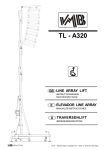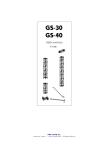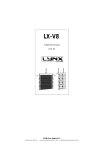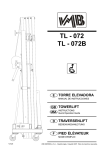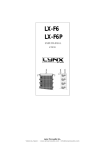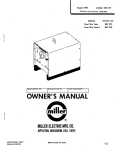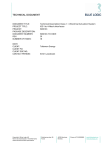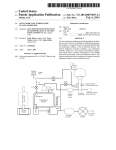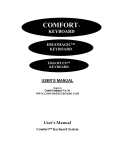Download manual tl-070 refinitivo a4
Transcript
TL-070 E TORRE ELEVADORA MANUAL DE INSTRUCCIONES GB TOWERLIFT USA INSTRUCTIONS Quick Operation Guide Recycled paper TORRE ELEVADORA TOWERLIFT TRAVERSENLIFT PIED ÉLÉVATEUR TL-070 Fabricante - Manufacturer - Hersteller - Fabricant VMB Española S.A. Calle 2 - Pol. Ind. Picassent E-46220 Picassent TL-070 W N1 N2 O J S U F H P T R V Q Manual de instrucciones 1. ESPAÑOL CONTENIDO 2.4 - Carga mínima elevable : 50 Kg. 1. Introducción 2. Datos técnicos 3. Normas de seguridad 4. Instrucciones de uso 5. Mantenimiento 6. Resolución de problemas 2.5 - Altura máxima : 6,40 m. INTRODUCCION Estimado usuario, Lea atentamente este manual. Observe los datos técnicos y siga las normas de seguridad antes de utilizar la torre elevadora. Los elevadores VMB son sometidos a durísimas pruebas para garantizar la máxima fiabilidad y resistencia. La torre TL-070 está especialmente concebida para trabajar con total fiabilidad y seguridad. Su mecanismo de elevación incorpora el sistema de seguridad ALS «auto-lock safety» exclusivo de VMB. Este manual deberá estar disponible permanentemente junto a la torre elevadora. En caso de necesitar piezas de repuesto, diríjase a su distribuidor habitual. Solamente deben utilizarse piezas de repuesto originales. El usuario perderá todos sus derechos de garantía si incorpora cualquier repuesto que no sea original o realiza cualquier modificación en la torre. Para cualquier consulta sobre la torre deberá indicar el número de serie y año de construcción. 2. DATOS TECNICOS 2.1 - Torre elevadora modelo TL-070 2.2 - Diseñada para levantar cargas en sentido vertical a diferentes alturas. 2.3 - Carga máxima elevable : 250 Kg. 2.6 - Altura mínima : 2,20 m. 2.7 - Superficie de la base : 1,99 x 1,99 m. 2.8 - Peso de transporte : 113 Kg. 2.9 - Material de construcción : Cuerpo principal en perfil de aluminio extrusionado 6082T6. Base y patas en perfil de acero según DIN 2394. Gatillos y cremallera de seguridad en acero ST-37. 2.10 - Sistema deslizante sobre patines de nylon de 4 tramos accionado por una combinación de cable de acero en doble sirga y cadenas, todo ello guiado por poleas acanaladas con cojinetes de rodamiento a bolas. Sistema exclusivo VMB (mod. ut. pen. 200202230) 2.11 - Cabrestante : 900/1000 Kg. de carga máxima con freno automático de retención de la carga. Certificación CE y GS VBG 8. 2.12 - Cable : Acero según DIN 3060. Calidad 180 Kg/mm2 resistente a la torsión. Diámetro 6 mm. 2.13 - Cadenas de suspensión de mallas juntas 4x4 de 1/2'' capacidad máxima 3.600 Kgs. 2.14 - Platillos estabilizadores ajustables en las patas, con apoyos antideslizantes de caucho. 2.15 - Anclaje de las patas por gatillos de seguridad. 2.16 - Nivel de burbuja para ajustar la posición vertical de la torre. 2.17 - Protección antióxido y acabado por cadmiado electrolítico. 2.18 - Ruedas direccionables para facilitar el transporte de la torre en posición vertical y plegada hasta su emplazamiento de trabajo. Manual de instrucciones 3. NORMAS DE SEGURIDAD. ESPAÑOL ! 3.1 - El elevador TL-070 es una máquina diseñada para la elevación de cargas en sentido vertical, NUNCA se debe utilizar como plataforma elevadora de personas. 3.2 - Colocar el elevador sólo en superficies duras y planas, verificando que está en posición vertical, mediante el nivel de burbuja (F) situado en el tramo base. Ajustar si fuera necesario con los platillos de apoyo (Q), girando la manivela (H) en el sentido adecuado. Nunca utilice cuñas ni elementos extraños para equilibrar el elevador. 3.3 - Comprobar que las patas están correctamente montadas y sujetas por sus pasadores retenedores de seguridad. 3.4 - Nunca se debe elevar una carga sin antes verificar que está correctamente apoyada y centrada en los soportes elevadores adecuados, de forma que el peso de la carga sólo actúe en sentido vertical. K gs 3.5 - No se debe sobrepasar la capacidad de carga máxima indicada en la etiqueta de características del elevador y en este manual de instrucciones. Manual de instrucciones ESPAÑOL 3.6 - Si existe posibilidad de viento fuerte o en ráfagas, coloque el elevador en suelo firme y asegúrelo con la ayuda de tirantes. Nunca fije un tirante sobre un vehículo o cualquier otro elemento que pueda desplazarse. 3.7 - No use escaleras encima del elevador ni las apoye en él para realizar ningún tipo de trabajo. 3.8 - Tenga cuidado con todo tipo de salientes por encima del elevador como cornisas, balcones, letreros luminosos, etc... Es muy importante evitar la presencia de cables por debajo de la altura de trabajo del elevador. 3.9 - Nunca se ponga debajo de la carga ni permita la presencia de otras personas en la zona de trabajo del elevador. 3.10 - No desplace nunca el elevador si se encuentra con la carga elevada. No es aconsejable realizar ningún tipo de movimiento, ni tan siquiera pequeños ajustes de posicionamiento. 3.11 - No utilice nunca el elevador sobre ninguna superficie móvil o vehículo. Manual de instrucciones ESPAÑOL 3.12 - Antes de utilizar el elevador, verifique el estado del cable. El cable no debe presentar rotura de hilos o aplastamiento. NUNCA use cables defectuosos y en caso de duda cambie el cable. Sólo utilice cable de acero según DIN 3060. Calidad 180 Kg/ mm2 resistente a la torsión. 3.13 - Nunca desmonte la manivela del cabrestante si el elevador está con carga y elevado. -50 3.14 - La carga mínima para un funcionamiento del freno sin problemas es de 50 Kg. Sin esta carga mínima el freno no actuará. 3.15 - No engrase ni lubrique el mecanismo de freno del cabrestante. Los discos de freno, han sido engrasados con una grasa especial resistente al calor y la presión. No deben ser utilizados otros productos para evitar influir negativamente en el funcionamiento del freno. 3.16 - Para el transporte del elevador hay que bajar todos los tramos. 3.17 - Solamente deben utilizarse piezas de repuesto originales. OR I GI N A L Manual de instrucciones ESPAÑOL Distancia del centro de la carga a la torre 4. Instrucciones de uso. 4.1 - Coloque la torre elevadora apoyada en sus ruedas de transporte (T) sobre una superficie plana y firme en su emplazamiento de trabajo. 4.2 - Saque las patas de su soporte para transporte (S) e insértelas a fondo en sus alojamientos de trabajo (V) comprobando que quedan sujetas por los gatillos retenedores (R). 4.3 - Ajuste la posición vertical de la torre mediante los platillos de apoyo regulables (Q) girando las manivelas de las patas estabilizadoras para lograr que la burbuja del indicador de nivel (F) quede centrada en el círculo. A B C D E F G H I 25 cm 30 cm 40 cm 50 cm 60 cm 70 cm 80 cm 90 cm 100 cm Carga máxima elevable 250 kg 208 kg 156 kg 125 kg 104 kg 89 kg 78 kg 69 kg 62 kg Para montajes con el kit de elevación VMB BS-070, o brazos de carga similares, la capacidad máxima de la torre depende de la distancia de carga en el soporte. 4.4 - Coloque los brazos de carga en posición horizontal y fíjelos con los pasadores de seguridad. También puede elevar todo tipo de cargas sueltas (nunca puentes) usando directamente las abrazaderas alicraft del carro elevador. VMB aconseja los kit de elevación SU-070 y BS-070, especialmente diseñados para la elevación de cargas con la torre TL-070. 4.5 - LA CARGA MÁXIMA ES DE 250 Kg. Nunca debe sobrecargarse la torre por encima de su carga máxima de trabajo (250 kg). La seguridad de trabajo es lo más importante. Coloque la carga sobre la torre mediante un soporte adecuado según el caso, de forma que el peso de la carga sólo actúe en sentido vertical. La carga mínima es de 50 Kg. 4.6 - Colocar la carga Cuando utilice brazos de carga coloque SIEMPRE la carga lo más cerca posible de la torre. La carga máxima de la torre TL-070 disminuye con la distancia al cuerpo de la torre. Véase cuadro de cargas en función de la distancia. El Kit SU-070 está preparado para la carga frontal de trusses de sección triangular o rectangular de todas las dimensiones desde 25 cm a 52 cm. El Kit BS-070 de brazos puede utilizarse tanto para la carga lateral como frontal. La carga máxima elevable con estos brazos es de 250 kg cuando el centro de la carga se sitúa a menos de 25 cm del carro elevador. Manual de instrucciones Cargar un puente Para elevar un puente de manera LATERAL puede colocarlo apoyado sobre el kit de brazos BS-070. Cuando trabaja con UNA sola torre también puede apoyarlo sobre las abrazaderas del carro. NUNCA utilice las abrazaderas para elevar con varias torres. Para cargar puentes de manera frontal utilice el Kit de brazos cortos SU-070. Este kit permite cargar todo tipo de trusses de sección triangular o rectangular entre 25 y 52 cm. Con el Kit de brazos largos BS-070 también pueden cargar trusses frontalmente. Cargar estructuras Para elevar puentes y sistemas estructurales con varias torres a la vez, utilice siempre el Kit de brazos largos BS-070 apoyando la estructura sobre dichos brazos de forma que esta no quede fijada rígidamente. NUNCA cargue las estructuras directamente sobre las abrazaderas alicraft del carro cuando la carga deba ser elevada por varias torres enfrentadas y de manera simultánea. MUY IMPORTANTE: Cuando se utilizan dos torres para elevar un puente, o varias torres para elevar una estructura rectangular o de cualquier otra forma, es muy dificil que varias personas accionen los cabrestantes y eleven o bajen las torres exactamente por igual. En un momento determinado cada torre puede estar situada a una altura muy diferente de las demás. Es necesario que las sujeciones de la estructura permitan las holguras y articulaciones necesarias para absorber las diferencias entre la altura de cada torre. Con una fijación rígida, si la diferencia de nivel es importante, la fuerza del brazo de palanca generado forzará lateralmente las torres pudiendo llegar a frenarlas y bloquearlas. Además puede llegar a deformar la propia estructura de truss. ESPAÑOL Sistema de seguridad ALS La torre TL-070 dispone del sistema de seguridad ALS autolock security (gatillo rojo). ALS es un mecanismo de seguridad patentado y exclusivo de VMB. El sistema ALS bloquea automáticamente la torre en cualquier posición que se deje. Cada tramo de cadena incorpora además un sistema de seguridad ALS (automatic lock security) que bloquea el tramo en el caso poco probable de rotura de la cadena. 4.7 - Elevar: No elevar la torre sin una carga mínima de 50 kg. Para elevar quite el bloqueo (O) y gire la manivela del cabrestante. La carga se elevará hasta la altura deseada. En caso de subir la torre sin carga o con una carga inferior a 50 kg, los sistemas de seguridad bloquearán la torre automáticamente a la altura elevada y no podrá bajarse. Podría llegar a bajar el tramo del cable dejando las cadenas sueltas. La torre quedará bloqueada y para poder bajarla será necesario colgar del carro elevador una carga superior a 50 kg. Entonces habrá que subir de nuevo la torre hasta tensar cable y cadenas, para liberar los sistemas de seguridad. Una vez tensado el cable y las cadenas se podrá bajar normalmente, manteniendo desenclavado el gatillo rojo ALS AutoLock. 4.8 - Aguantar: Suelte la manivela del cabrestante y la torre se mantendrá en esa posición por la actuación del freno automático accionado por la carga. La torre puede dejarse en cualquier posición intermedia que se necesite, soltando simplemente la manivela. 4.9 - Descenso: Para bajar la torre levante el gatillo rojo de seguridad y manteniéndolo levantado, gire la manivela del cabrestante. La carga irá descendiendo con los diferentes t r a m o s h a s t a q u e l a t o r r e q u e d e completamente plegada a su altura mínima. Manual de instrucciones La torre puede dejarse en cualquier posición intermedia que se necesite del mismo modo que al subir la carga. En caso de que el gatillo esté bloqueado por la carga, hay que subir ligeramente la torre girando la manivela del cabrestante para después, una vez liberado el gatillo, ir bajando con normalidad. 4.10 - Transporte: Pliegue la torre bajando completamente los tramos. Una vez plegada fije el carro elevador con el soporte (O). Desmonte las patas liberando los gatillos de retención y colóquelas en su posición de transporte (S). Apriete los tornillos (J). ESPAÑOL 5.3 - La torre elevadora TL-070 debe ser comprobada por un experto como mínimo una vez al año de acuerdo con su utilización. 5.4 - Solamente deben utilizarse piezas de repuesto originales para garantizar una continuada seguridad de uso. El usuario pierde todos los derechos de garantía si incorpora otros repuestos que no sean originales o lleva a cabo cualquier modificación en el aparato. 5.5 - Para solicitar cualquier pieza de repuesto, debe indicarse su número de referencia, que figura en las hojas de despiece de este manual. 5. Mantenimiento. 6. Resolución de problemas. 5.1 - Compruebe periódicamente el estado del cable. Si un cable presenta rotura de hilos o aplastamiento, debe ser substituido inmediatamente por otro nuevo. No utilice la torre con cables en mal estado. Utilice solamente cable de acero DIN 3060 resistente a la torsión. -Si la torre va muy dura... 5.2 - La torre elevadora se suministra completamente engrasada de fábrica. No obstante, se recomienda engrasar periódicamente (según el uso) la corona dentada del cabrestante, los cojinetes del árbol de accionamiento y el buje, la rosca de la manivela y los tramos. ATENCION: No engrasar ni lubricar el mecanismo del freno. No es necesario engrasar los discos de freno. Los discos de freno han sido engrasados con una grasa especial resistente al calor y la presión. No deben ser utilizados otros productos para evitar influir negativamente en el funcionamiento del freno. Compruebe si la carga total excede los 250 Kg. No sobrepase esta carga máxima. Compruebe que la carga esté colocada correctamente. Consulte el cuadro de cargas y distancias del punto 4 de este manual. La carga no debe estar demasiado separada (excesiva distancia) del cuerpo de la torre. Coloque la carga correctamente y siempre lo más cerca posible del cuerpo de la torre. En caso de trabajar con varias torres, compruebe que las torres estén elevadas a la misma altura. Si las alturas son diferentes, las torres están realizando una fuerza lateral que provoca su frenado. Iguale siempre las alturas y suba de forma nivelada. Compruebe que las fijaciones de la estructura a elevar no sean rígidas permitiendo las holguras necesarias para una elevación manual. Coloque siempre una fijación de forma que permita ligeros desplazamientos del apoyo. Utilice los Kits de carga SU-070 y BS-070. Manual de instrucciones -Si la torre no baja Puede ser debido a que la torre se ha elevado sin carga o con una carga inferior a 50 Kg. Coloque en el carro elevador (ref.7056) una carga superior a 50 Kg. Eleve de nuevo la torre para tensar las cadenas y liberar el sistema de seguridad. Después gire la manivela del cabrestante y haga descender la torre con normalidad, manteniendo levantado el gatillo rojo ALS. Si está utilizando varias torres, para elevar un puente o estructura, puede que al tratar de bajar la estructura las torres queden bloqueadas. Esto es debido a que la acción manual para bajar varias torres no es exactamente la misma y pueden haber diferencias de altura entre el conjunto de torres. Compruebe las sujeciones de la torre a la estructura. Si trabaja con sujeciones rígidas para cargar las estructuras a la torre, esa rigidez impide la absorción de las diferencias de altura entre las torres y estas pueden quedar frenadas debido al esfuerzo lateral de palanca, lo cual activa el sistema de seguridad ALS de los tramos bloqueando la torre. Primero suba las torres que estén más bajas hasta la misma altura que las demás. Después vuelva a elevar todas las torres por igual unos 10 cm, hasta tensar las cadenas y liberar los sistemas de seguridad ALS de los tramos de cadena. De esta manera desbloqueará las torres. Para finalizar, baje todas las torres a la vez, de forma que el conjunto esté lo más nivelado posible. Cambie inmediatamente la forma de sujeción. Siempre que trabaje con varias torres deje un mínimo de juego en las sujeciones para absorver las diferencias de altura durante la elevación y el descenso. VMB recomienda los soportes PS-04 y PS-05 con sujeción tipo U. ESPAÑOL TORRE ELEVADORA TL-070 PRODUCTO FABRICADO POR: VMB Española S.A. Calle 2 - Pol. Ind. Picassent E-46220 Picassent Declaración de conformidad CE según la norma de la CE sobre máquinas 89/392/CE Declaramos que las torres VMB -modelo TL-070 corresponden, con un uso correcto para la elevación y descenso de cargas, a las disposiciones de la normativa de máquina 89/392/CE, las demás normativas CE y ampliaciones correspondientes. La torre elevadora TL-070 ha sido probada según la norma BGV C1 (GUV 6.15) / BGG 912 (GUV 66.15) obteniendo la certificación de prueba con fecha 08/07/02 Las pruebas han sido realizadas por IBB ingenieure sachverständige Dipl. - Ing. univ. Olaf Brandt Nollendorfstrasse 18 D-45472 Mülheim an der Ruhr La torre TL-070 suministrada corresponde a la muestra verificada. Quick Operation Guide CONTENTS 1. 2. 3. 4. 5. 6. Introduction. Technical information. How to place the load How to load structures How to load a bridge Trouble shooting ENGLISH 2.3 - Maximum load : 550 lbs / 250 Kg. 2.4 - Minimum load : 110 lbs / 50 Kg. 2.5 - Maximum height : 21 ft / 6,4 m. 2.6 - Minimum height : 7.2 ft / 2,2 m. 2.7 - Area of base : 6.5x6.5 ft / 1,99x1,99 m. 2.8 - Unit weight : 248.6 lb / 113 Kg. 1. INTRODUCTION Dear customer, In order to operate the towerlift TL-070 in a safe and reliable manner, follow the instructions in this booklet. Before operating the lift, read the instructions carefully. Please note the technical information. Our products undergo very rigorous testing under strict conditions and they are monitored continuously during the manufacturing process. 2.9 - Construction material : Main body in extruded aluminium 6082-T6 profile. Base and legs are made of steel profile according to DIN 2394. Catches and safety rack of ST-37 steel. 2.10 - Exclusive system (mod. ut. pen. 200202230) 2.11 - Winch : 900/1000 Kg. of maximum load with automatic brake to stop the load. 2.12 - Cable : Steel DIN 3060. Quality 180 Kg/ mm2 twist resistant. Cable diameter : 6 mm. 2.13 - Chains 4x4 of 1/2'' maximum capacity of 3.600 Kgs. In order to guarantee the lift function and safety, the original parts of the manufacturer's design must be used. If any parts other than those of the manufacturer are used, or the product is modified in any way, the user forfeits all warranty rights to claim. 2.14 - Adjustable stabilizing feet with ruber non-slip supports. VMB reserves the right to modify the product specifications without prior notice. The model type, production year and serial number must be quoted in any queries or orders for spare parts. 2.17 - Antirust protection and cadmium plating. 2. TECHNICAL INFORMATION 2.1 - Towerlift TL-070. 2.2 - Designed to lift loads vertically to different heights to support lighting systems. 2.15 - Safety catches to anchor the legs. 2.16 - Spirit level to adjust the tower vertically. 2.18 - Swivel wheels to transport the lift when folded. Quick Operation Guide 3. SAFETY PRECAUTIONS. ENGLISH ! 3.1 - The TL-070 is a machine designed to elevate loads upwards in a vertical direction, NEVER should it be used as a platform to elevate people. 3.2 - Only place the lift on hard, flat surfaces always checking that it is in a vertical position by using the bubble level indicator (F) found on the base section. Adjust the outrigger stabilisers (Q) by turning the cranks to level if necessary. NEVER use wedges or other foreign objects to bring the lift to equilibrium. 3.3 - Check that the outriggers are placed and set-up correctly using the pins safety system. 3.4 - NEVER should the lift be used to elevate a load that has not been properly checked. It is necessary to verify that the load is correctly supported and centred on the appropriate lift support so that the weight of the load will only elevate in a vertical direction. K gs 3.5 - The maximum load indicated on the characteristics label and the instructions manual should not be exceeded Quick Operation Guide ENGLISH 3.6 - If there is a possibility of strong winds or gusts, place the lift on the ground firmly and secure it with the use of straps. NEVER attach a strap to a vehicle or any other object that can possibly be moved. 3.7 - Do not use stepladders on the lift or use it as a support for them. 3.8 - Take care with all obstacles above the lift and its extension zone such as cornices, balconies, and luminous signboards. It is very important to avoid the presence of all types of cables below the extended lift. 3.9 - NEVER allow any team member below the load or anybody else in the lifts operating zone. 3.10 - NEVER move the lift whilst it is carrying a load. It is not advisable to carry out any type of movement even small positional adjustments. 3.11 - NEVER use the lift on a vehicle or any other mobile surface. Quick Operation Guide ENGLISH 3.12 - Before using the lift, check the state of the cable. The cable should not contain broken threads or show any signs of crushed/flattened areas. NEVER use faulty cables, always change them if there is any doubt. Only use steel cables reference: DIN 3060. Quality: 180KG/mm and torsion resistant. 3.13 - NEVER take apart the crank of the winch when the lift is carrying a load or extended. -50 3.14 - The minimum load to avoid problems regarding the breaking mechanism is 50KG. Without this load the brake will not work. 3.15 - Do not grease or lubricate the winch’s breaking mechanism. The brake disks have been greased with a special heat and pressure resistant solution. Other products should not be used to avoid negative effects regarding the braking mechanism. 3.16 - All sections must be lowered during transportation. 3.17 - Only original replacement parts should be used. OR I GI N A L Quick Operation Guide ENGLISH Load centre’s DISTANCE to the lifting carriage 4. USAGE INSTRUCTIONS. 4.1 - Place the lift on a firm, flat surface in the area it is to be used supported its transport wheels (T). 4.2 - Remove the outriggers from their transport supports (S) and fully insert them into their positions (V) checking that they are fixed by the pins (R). A B C D E F G H I 10 ‘‘ - 25 cm 12 ‘‘ - 30 cm 16 ‘‘ - 40 cm 20 ‘‘ - 50 cm 24 ‘‘ - 60 cm 28 ‘‘ - 70 cm 32 ‘‘ - 80 cm 36 ‘‘ - 90 cm 40 ‘‘ -100 cm Maximum lifting LOAD 550 lb - 250 kg 457 lb - 208 kg 343 lb - 156 kg 275 lb - 125 kg 229 lb - 104 kg 196 lb - 89 kg 171 lb - 78 kg 152 lb - 69 kg 136 lb - 62 kg 4.3 - Adjust the outrigger stabilisers (Q) by turning the cranks to level the lift. Ensure it is in a vertical position by using the bubble level indicator (F) found on the base section. The bubble should be in the centre of the circle. 4.4 - Place the forklifts in a horizontal position and secure them with the pins. VMB recommends the SU-070 Elevation Kit and the BS-070 Elevation Kit which have both been especially designed for loading and elevating with the TL-070. 4.5 - THE MAXIMUM LOAD IS 250KG. The lift should NEVER be overloaded (over 250KG). Safety at work is the most important element. Place the load onto the lift using an adequate support according to the need, use so that the weight of the load will only elevate in a vertical direction. The minimum load is 50KG 4.6 - How to place the load Always load as close to the tower as possible. The maximum load diminishes according to the distance from the body of the tower as illustrated in the diagram below. The maximum load is 250 kg when the load’s centre is at 25 cm from the lifting carriage of the towerlift. VMB recommend the use of the VMB special support kits SU-070 and BS-070. The SU-070 Kit is prepared for frontal loading of triangular or rectangular trusses of all the dimensions from 25 cm to 52 cm. The BS-070 Kit can be used for frontal or lateral loading. How to load a bridge To lift a bridge you can use the VMB kits SU070 and BS-070. To load bridges of both triangular and rectangular trusses measuring between 25 and 52 cm, the SU-070 Kit can be used for frontal mountings. BS-070 can be used for frontal or lateral loading. NEVER use the half couplers alicraft to lift a bridge. Quick Operation Guide ENGLISH How to load structures To elevate structures it is necessary to use the BS-070 Kit. The arms support the structure but not in a rigid position. Security system ALS The TL-070 incorporates the patented security system ALS (Automatic Lock Security). This VMB red trigger system automatically blocks the tower in the position it is left in. Each section of chain has an ALS that blocks the section in the unlikely event of the chain breaking. DO NOT LOAD STRUCTURES DIRECTLY ONTO THE ALUMINUM HALF COUPLERS ON THE TROLLEY CAUTION When two towers are used to elevate a bridge or many towers to elevate a structure of any type, it is almost impossible that two or more people co-ordinate the winches elevating or lowering the loads, at exactly the same pace. At a certain point each tower will be extended to a height different to that of the others. For this reason it is necessary that the subjections of the structure account for this and allow for these differences. With a rigid fixation and if the level difference is significant, the force generated from the handle of the winch will deform the structure and apply a lateral force to the lifts causing them to break and block. 4.7 - Lift: DO NOT ELEVATE THE LIFT WITHOUT A MINIMUM LOAD OF 50kg Elevating the lift without any minimum load will cause the ALS to block the lift while extended and it will not descend, it may even lower the section of the cable leaving the chains loose. The lift will remain blocked but to release and lower it, it is necessary to apply the minimum load of 55 lb (25kg). Then the lift needs to be raised so as to tighten the cable and chains to free the security systems. When the cable and chains have been tightened it is possible to lower the lift normally, of course making sure the red ALS latch is held up. 4.8 - Hold: The tower can be left in any intermediate position which would be necessary. Just stop turning the handle of the winch and left it. The automatic brake of the winch will block it and hold the load. 4.9 - Lowering: To low the load lift the blockade on the red safety trigger and rotate the handle of the winch until the tower will be completely folded at his minimal height. The load will be lowed. 4.10 - Transport: For the transport of the tower is necessary to fold the machine lowering completely all the profiles. Once the towerlift is folded it is very important to blockade the lifting carriage with its transport support (O). Get out the legs leaving the blockade on the triggers and put them in their transport lodging (S). Then press the fastening screws. Quick Operation Guide ENGLISH 5. MAINTENANCE. 6. TROUBLE SHOOTING 5.1 - Regularly check the state of the cable. If the cable has broken threads, or if it shows any signs of crushed/flattened areas, it should be changed and replaced immediately by a new one. Do not use the lift if the cables are in bad condition. Only use steel cables reference: DIN 3060 torsion resistant. - HARD TO ELEVATE: 5.2 - The lift is supplied from the factory completely greased. However, it is recommended to periodically grease according to use, the gearing, the axis bearings, the spiral of the crank, and the sections. REMEMBER: NEVER grease or lubricate the breaking mechanism. It is not necessary to grease the brake disks. The brake disks have been greased with a special heat and pressure resistant solution. Other products should not be used to avoid negative effects regarding the braking mechanism. 5.3 - An expert should check the TL-070 at least once a year according to its usage. Consult your distributor. 5.4 - Only original replacement parts should be used to guarantee continued safety during usage. The user loses all guarantee rights if he/she uses replacement parts that are not original or if he/she makes any modification to the apparatus. 5.5 - To order any replacement parts, the reference number on the replacement parts pages in this manual should be indicated. Check that the total load does not exceed 550 lb (250 kg) DO NOT TO EXCEED THE MAXIMUM LOAD. Check that the load is not placed excessively from the body of the tower according to diagram in this quick operation guide. ALWAYS LOAD AS CLOSE TO THE LIFT AS POSSIBLE. Check that the lifts in use when elevating a bridge or truss structure are at equal heights and not causing force laterally causing them to brake. If this is the case adjust the heights and continue to elevate the load in a horizontal position. Check that the fixations of the bridge or structure are not rigid whilst elevating and that they allow for the necessary movements during elevation. Place the fixation so that it allows for slight displacements of the support. Use the loading kits SU-070 & BS-070. -DIFFICULTY IN LOWERING THE LIFT WHEN EXTENDED. As explained above, it is necessary to apply the minimum load of 110 lb (50kg). If this is not the case and the lift does not descend, carry out the following: A. Extend the lift to tighten the cable and chains to free the security system. B. When the cable and chains have been tightened it is possible to lower the lift normally C. Make sure the red ALS latch is held up. Quick Operation Guide Check that the fixations of the bridge or structure are not rigid whilst elevating and that they allow for the necessary movements during elevation. The security system will have blocked the towers automatically. Change the subjection carry out the instructions indicated below . Firstly elevate the lifts that are lower, to the same height as the others. Elevate the lifts simultaneously about 10 centimetres tightening the chains and releasing the ALS security systems on the chain sections unlocking the lifts Lower the lifts simultaneously with the load in a horizontal position. VMB recommends the PS-04 and PS-05 supports with fixation pieces type U. -WHEN THE LIFT IS BLOCKED When working with several towerlifts, firstly elevate the lifts that are lower, to the same height as the others. Elevate the lifts simultaneously about 10 centimetres tightening the chains and releasing the ALS security systems on the chain sections unlocking the lifts Lower the lifts simultaneously with the load in a horizontal position. ENGLISH TOWERLIFT TL-070 PRODUCT MANUFACTURED BY: VMB Española S.A. Calle 2 - Pol. Ind. Picassent E-46220 Picassent EC Conformity Declaration pursuant to the EC Machinery Directive 89/392 EEC We hereby declare that VMB towerlifts -model TL-070 satisfy the EC Machinery Directive 89/392 EEC regulations, relevant EC directives and amendments when used for lifting and lowering loads as directed TL-070 towerlifts have been tested corresponding the regulations BGV C1 (GUV 6.15) / BGG 912 (GUV 66.15) obteining the Test Certification on 14/03/97 Examining and Certification have been made by IBB ingenieure sachverständige Dipl. - Ing. univ. Olaf Brandt Nollendorfstrasse 18 D-45472 Mülheim an der Ruhr The towerlift TL-070 supplied conform to the tested types. TL-070 A D B C 7056 TL-070 7013 7011 ALS 7050 7051 7043 7052 7055 7055 7054 7054 7053 7502-G 7503 7057 2170 2034 E 2026-B 7056 TL-070 A-2 A 7004 7024 7020 A-3 7020 7011 7064 7066 7065 7065 A-1 7013 7043 7019 A-1 7008 7046 7035 7006 7035 7023 7047 7049 7004 7045 7005 7047 7036 A-2 7034 7033 7020 7009 7023 7018 7010 7032 A-3 7019 7020 7022 TL-070 B 7042 7537 7538 7539 7042 7538 7537 7539 C 7057 7062 7059 7058 7061 7061 7060 7060 TL-070 D 2037 2037 2029 2161 2050 2051 2029 2050 7048 2051 2161 7015 2051 2046 2047 7048 2048 7015 2049 2047 2030 2048 2049 7067 2030 TL-070 7020 E 7019 7029 7032 7031 7038 7037 7028 7031 7029 7027 7037 7025 7025 7026 7028 7037 7027 7026 LOAD SUPPORTS 7040 PS-04 7041 PS-05 7023 LISTA DE PIEZAS TL-070 / SPARE PARTS LIST Ref. Descripción / Description : 2026-B 2029 2030 2034 2037 2046 2047 2048 2049 2050 2051 2161 2170 7001 7002 7003 7004 7005 7006 7008 7009 7010 7011 7013 7015 7018 7019 7020 7021 7022 7023 7024 7025 7026 7027 7028 7029 7031 7032 Gatillo seguridad / Safety catch. Pomo baquelita / Crank nob. Platillo de apoyo / Stabilizer round plate. Nivel de burbuja / Bubble level. Tornillo M-8 / M-8 screw. Tuerca M-6 / M-6 nut. Arandela / Washer. Arandela / Washer. Tornillo M-6 / M-6 screw. Tornillo M-5 / M-5 screw. Tuerca M-8 / M-8 washer. Manivela / Steel hand crank. Pomo M-8 / M-8 cranck nob. Patín tetones / Centrator sliding profile. Patín U / U Centrator sliding profile. Patín L / L Centrator sliding profile. Polea cable con rodamiento a bolas / Ball bearing cable pulley. Soporte polea 7004 y gatillo ALS / Pulley 7004 and ALS trigger support. Bulón acero eje polea 7004 / Pulley 7004 steel axe. Soporte cadena 7020 / Chain 7020 support. Bulón acero eje polea 7018 / Pulley 7018 steel axe. Soporte polea cadena 7018 / Chain pulley 7018 support. Corredera ALS auto-lock security / ALS track. Gatillo ALS / ALS trigger. Tapón pata y soporte apoyo / Leg stabilizer guide. Polea cadena con rodamiento a bolas / Ball bearing chain pulley. Fijación cadena 7020 / Chain 7020 fixation. Cadena tracción AL-444 / Chain AL-444. Abrazadera aluminio / Half coupler. Eje acero cadena 7020 / Chain 7020 steel axe. Arandela de presión / Pressure washer. Pletina soporte polea interior cable 7004 / Cable 7004 internal pulley support plate. Pieza sujeción mecanismo del freno / Brake mechanism fixation piece. Eje de acero del seguro / Safety steel axe. Gatillo de bloqueo / Trigger. Varilla roscada especial tensor / Special stick. Pletina de acero soporte / Support steel plate. Pieza sujeción varilla tensor / Fixation special stick piece. Pieza fijación cadena 7020 / Chain 7020 fixation piece. LISTA DE PIEZAS TL-070 / SPARE PARTS LIST Ref. Descripción / Description : 7033 7034 7035 7036 7037 7038 7039 7040 7041 7042 7043 7045 7046 7047 7048 7049 7050 7051 7052 7053 7054 7055 7056 7057 7058 7059 7060 7061 7062 7064 7065 7066 7067 7502-G 7503 7537 7538 7539 Arandela especial pequeña / Special small washer. Arandela especial grande / Special big washer. Arandela / Washer. Placa refuerzo gatillo ALS 7013 / ALS 7013 reinforcement plate. Muelle / Spring. Tuerca / Nut. Estabilizador completo / Complete stabiliser. Brazo de carga largo / Load support long fork. Brazo de carga corto / Load support short fork. Pieza bloqueo trasporte / Lock piece for transport. Cable acero / Steel cable. Pletina de acero / Steel plate. Pieza de refuerzo / Reinforcement piece. Tornillo M-8 / M-8 screw. Perno roscado M-18 / M-18 screw. Tornillo M-8 / M-8 screw. Tramo 1 / Profile section 1. Tramo 2 / Profile section 2. Tramo 3 / Profile section 3. Tramo 4 / Profile section 4. Pata corta completa / Complete short legs stabiliser. Pata larga completa / Complete long legs stabiliser. Ruedas tramo base / Base wheels. Carro elevador / Lifting carriage. Perno roscado M-10 / M-10 screw. Tornillo M-10 / M-10 screw. Tuerca M-10 / M-10 nut. Arandela M-10 / M-10 washer. Abrazadera de aluminio / Aluminium half coupler. Tornillo M-12 / M-12 screw. Tornillo M-6 / M-6 screw. Tuerca M-12 / M-12 nut. Estabilizador completo / Complete stabiliser. Cabrestante / Winch. Tirantes sujección patas / Base profile strut. Muelle / Trans locker spring. Arandela / Spring washer. Pasador acero / Steel pin. VMB ESPAÑOLA S.A. Pol. Ind. Picassent - Calle 2, final - 46220 Picassent (VALENCIA) Spain Tel.: +34 902 34 10 34 - Fax: +34 961 22 11 77 Web:www.vmb.es - E-mail: [email protected]

































